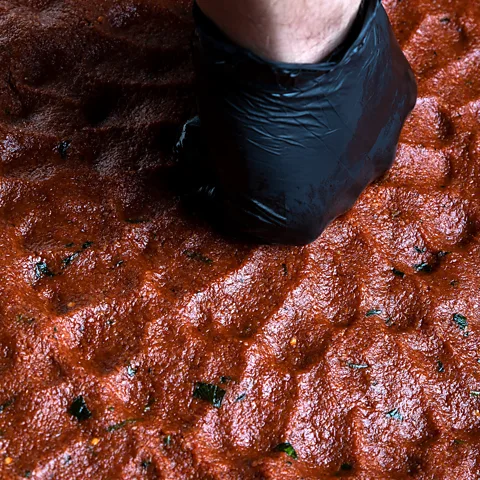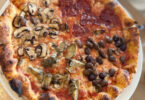Paul Benjamin Osterlund
One of the country’s most popular fast-food items, çig köfte is traditionally associated with wild and rowdy gatherings in south-eastern Turkey.
Those unfamiliar with Turkish cuisine may be unaware that one of the country’s most popular and ubiquitous dishes, found in thousands of kiosks throughout the country, is çig köfte. Although this literally translates to “raw meatball”, it has another surprise; more often than not, it’s made from entirely vegan ingredients.
Çig köfte traditionally contains a mixture of raw minced beef, bulgur wheat and a cornucopia of spices and greens. But when the dish was banned from sale in 2008 in accordance with EU health codes, most producers switched to a meat-free version made from bulgur and nuts wrapped in flatbread with rocket, parsley, iceberg lettuce, sliced tomatoes and a drizzle of pomegranate syrup. Over the past two decades, numerous chains have popped all over Turkey serving this cheap, fresh, healthy and tasty snack, making it a favourite among students and anyone looking for an affordable bite on the go.
Çig köfte comes from Turkey’s south-eastern provinces, and it is particularly associated with the cities of Adiyaman and Sanliurfa and a traditional gathering known as a sira gecesi where guests sip tea, engage in conversation and dine to a chorus of musicians playing local folk tunes. These ceremonies, which sometimes also involve alcohol, raucous loud music and dancing, have gained broader cultural significance throughout Turkey over the years, particularly as south-eastern cuisine has spread to Istanbul and other large cities in Turkey’s west. The centrepiece of the often wild and rowdy evening is çig köfte, which is prepared on the spot by a master chef who arduously mixes and kneads the ingredients by hand for an hour or longer until the proper consistency is achieved.
While the numerous chains that sell mass-produced çig köfte are banned from using raw meat, mom-and-pop establishments, who make them fresh, are still licenced to do so, and travellers interested in trying the traditional type should seek them out. An excellent place to start is Mahir Lokantasi, a highly acclaimed restaurant in the heart of Istanbul’s central Sisli district, which serves an impressive daily rotation of regional dishes from throughout Turkey. Owner and chef Mahir Nazlican, who hails from the south-eastern province of Diyarbakir, is particularly known for his excellent renditions of classic dishes from his part of the country – and one of these includes the original version of çig köfte.

“The most important part of çig köfte is that the meat that goes inside it must be high quality ground beef that is free of fat and tendons. Also, we use fine brown bulgur. Of course, you must use organic spices, and the tomato and pepper paste cannot come from a market, it must be homemade because the smell and taste is directly reflected in the çig köfte,” Tatlican says.
Çig köfte myths
A commonly repeated misnomer is that the chef hurls a fistful of çig köfte at the ceiling and if it sticks, then this means it is done and ready to serve. Regional experts refute this, noting that the sira gecesi typically takes place in someone’s home and it would be very rude to throw food at the ceiling.
Mahir Lokantasi opens at noon and there is normally a line out the door for much of the day, but Tatlican was gracious enough to invite me an hour beforehand to taste some of his çig köfte and explain its secrets. We started with a simple-but-delicious breakfast of soft, mozzarella-esque cheese from Diyarbakir, sliced tomatoes and peppers, black olives, extra virgin olive oil and warm, chewy, hand-shaped flatbread fresh from the oven. This gave our stomachs a firm foundation as we waited for the çig köfte.
“It must be kneaded well for an hour. What we refer to as raw meat actually becomes ‘cooked’ during the kneading process,” Tatlican said. This is an essential part of its preparation that gives diners the reassurance that the dish is safe to eat.
Soon enough our plate arrived, a colourful platter of greens topped with the hand-shaped morsels of çig köfte. We each grabbed a piece and nestled it in a formidable chunk of iceburg lettuce, squeezed a liberal dose of lemon juice on top, and dived in. The flavour wasboth rich and light, with notes of umami, spice and acidity. It did not taste like raw meat, and the hour-long kneading process fused the myriad ingredients into a whole that was greater than the sum of its parts. While it was not overwhelmingly spicy, it still packed a punch. Tatlican noted that the most crucial part of the spice blend includes a secret mixture known as “seven-variety”, which is composed of seven spices, in addition to high-quality isot (spicy black Urfa pepper flakes).
We were both full and I took half of the çiğ köfte to go, where I enjoyed it at home over the course of several days as it keeps well and retains its flavour while refrigerated. No one should ever think of throwing something this good at the ceiling.

Çiğ köfte recipe
by Mahir Tatlıcan
Serves 8-10
Ingredients
1kg fine brown bulgur wheat
600g of fat-free, tendon-free beef mince
3 grated tomatoes
1 white onion
6 cloves garlic
1 tbsp black pepper
1 tbsp cumin
1 tbsp “seven-variety” (as this is a secret spice blend it can be replaced with any herbs/spices according to taste
2 tbsp red pepper flakes
2 tbsp black Urfa pepper flakes
2 tbsp tomato paste
2 tbsp red pepper paste
250ml olive oil
250 pure pomegranate sauce (Mahir uses the Punica brand from Şanlıurfa)
1 tsp salt
Greens:
Finely chopped green onion, parsley and fresh mint leaves to taste
Instructions:
Step 1
With the exception of the greens, the pomegranate sauce and the olive oil, mix all the ingredients together and knead it firmly for close to an hour.
Step 2
Add the remaining ingredients and knead for an additional 10 minutes.
Step 3
Form small finger-shaped pieces of the çig köfte and serve alongside iceberg lettuce, rocket and lemon wedges.
Courtesy: BBC







